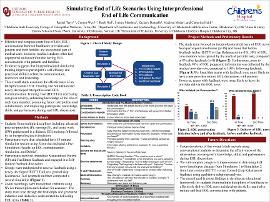| dc.contributor.author | Terry, Rachel | |
| dc.contributor.author | West, Connor | |
| dc.contributor.author | Nail, Kayli | |
| dc.contributor.author | Martinez, Sydney | |
| dc.contributor.author | Dunnells, Zackery | |
| dc.contributor.author | Meder, Madison | |
| dc.contributor.author | Heith, Catherine | |
| dc.date.accessioned | 2023-11-02T20:46:52Z | |
| dc.date.available | 2023-11-02T20:46:52Z | |
| dc.date.issued | 2023-02-17 | |
| dc.identifier | ouhd_Terry_simulatingendoflifescenarios_2023 | |
| dc.identifier.citation | Terry, R., West, C., Nail, K., Martinez, S., Dunnells, Z., Meder, M., and Heith, C. (2023, February 17). Simulating end of life scenarios using interprofessional end of life communication. Poster presented at Research Week, Oklahoma State University Center for Health Sciences, Tulsa, Ok. | |
| dc.identifier.uri | https://hdl.handle.net/11244/339932 | |
| dc.description.abstract | Introduction: Effective and compassionate End of Life (EOL) conversations between healthcare providers and patients and their families are an essential part of all medical care. However, many studies have found that medical students and residents often feel unprepared and uncomfortable to have EOL conversations with patients and their families. In addition, other healthcare providers such as nurses, respiratory therapists, and social workers feel unprepared to lead and participate in EOL conversations, especially early in their training. Evidence from previous studies points to a lack of consistent training in EOL conversations for healthcare providers. Caregivers receive irregular education, infrequent practice, and sporadic feedback on EOL conversations. Current medical educational practices and institutional culture in U.S. medical schools does not equip future physicians with the training and skills required for adequate EOL conversations. Training medical professionals to initiate and conduct effective and compassionate EOL conversations with patients and their families is crucial. Interprofessional simulation-based medical education was shown improve participant’s self-efficacy and perceived abilities relating to communication/teamwork and leadership/management of clinical scenarios. This study examines the effectiveness of an Interprofessional EOL Training and Simulation with intervention (specific) feedback versus control feedback in decreasing caregiver anxiety, enhancing knowledge of the role of each team member, promoting future interprofessional collaboration, and improving participants’ knowledge, skills, and performance during real EOL discussions. | |
| dc.description.abstract | Methods: All APPs (clinical nurse specialists (CNS), doctor of nursing practice (DNP), master of nursing education (MSN), nurse practitioners (NP), physician assistants (PA)) and APP students, chaplaincy students/trainees, chaplains, child life specialists, medical students, nurses, nursing students, physicians (residents, fellows and faculty), pharmacists and pharmacy students, respiratory therapists, social workers and social work students (henceforth referred to as ‘caregivers’) at the University of Oklahoma are eligible for participation in this study regardless of year of training/experience, sex, gender, race, or religion. Participation in this study was voluntary. Randomized groups of participants were placed into intervention (I Group) or control group (C Group). Participants were scheduled for a 145–165-minute simulation sessions with a Didactic Module, Pre-Simulation Huddle, an EOL communication simulation, and Debrief and Feedback sessions. | |
| dc.description.abstract | Results: The study team focused on interprofessional delivery of EOL news from participant simulations (n=18) and found that before feedback (n=10), 50% of EOL conversations were opened by the medical provider role, compared to 0% after feedback (n=8). Furthermore, prior to feedback 90% of EOL prognostic information was delivered by the medical provider role, compared to 100% following feedback. We found that teams with feedback were more likely to have a non-provider initiate EOL discussions with patients. However, teams with feedback were more likely to have the provider deliver the EOL news. | |
| dc.description.abstract | Conclusion: Future directions of this overall study include using conversational analysis to determine the effectiveness of the intervention on caregiver’s knowledge, skills, and performance during EOL discussions. We will compare caregiver’s improvement in delivering EOL news based upon changes from Simulation 1 to Simulation 2 from Intervention (IECTT) versus Control (Gap Kalamazoo) feedback using qualitative subgroup analyses. The overall goal is to use findings to develop an educational framework for students from multiple disciplines of healthcare to effectively deliver EOL news and develop the skills required to initiate and lead EOL conversations with patients. | |
| dc.format | application/pdf | |
| dc.language | en_US | |
| dc.publisher | Oklahoma State University Center for Health Sciences | |
| dc.rights | The author(s) retain the copyright or have the right to deposit the item giving the Oklahoma State University Library a limited, non-exclusive right to share this material in its institutional repository. Contact Digital Resources and Discovery Services at lib-dls@okstate.edu or 405-744-9161 for the permission policy on the use, reproduction or distribution of this material. | |
| dc.title | Simulating end of life scenarios using interprofessional end of life communication | |
| osu.filename | ouhd_Terry_simulatingendoflifescenarios_2023.pdf | |
| dc.type.genre | Presentation | |
| dc.type.material | Text | |
| dc.subject.keywords | end of life | |
| dc.subject.keywords | interprofessional communication | |
| dc.subject.keywords | simulation | |
